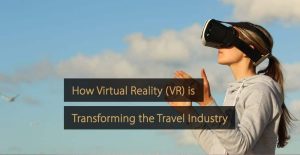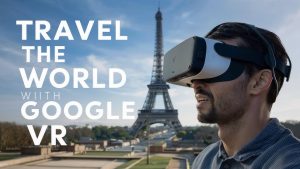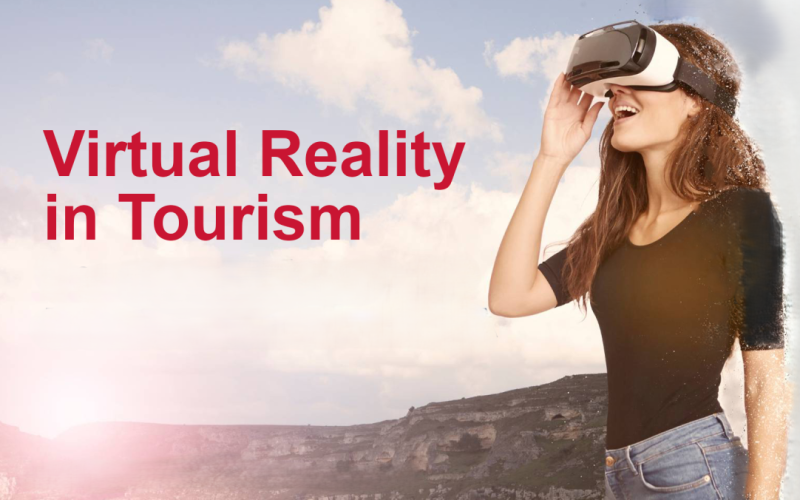Introduction
The world of travel is changing fast, and one of the most exciting new changes is virtual reality (VR). This cool technology is giving travelers a whole new way to explore places and plan their trips. Instead of just reading about a location or looking at pictures in a brochure, VR lets people step into a virtual world and experience a place as if they were really there. In this article, we’ll explore how virtual reality is changing travel and tourism, how it’s shaping the way we travel, and what the future holds for this exciting tech.
What is Virtual Reality in Travel and How Does It Work?

Virtual reality, or VR, is a technology that makes it possible for people to experience a simulated environment. Special headsets like Oculus Rift or HTC Vive provide a 360-degree view, making the experience feel real.
In travel, VR creates virtual tours of destinations, hotels, attractions, and even whole cities. With VR, you can “visit” a place and see what it’s like before you even go there. You can even interact with the virtual environment, making it feel more lifelike.
With VR, travelers can explore places like ancient Rome, tropical beaches, or historic landmarks without leaving their homes. This new way of experiencing destinations is changing how we discover places and plan trips.
How Virtual Reality is Changing Travel and Tourism

1. Virtual Tours of Destinations
One of the biggest ways VR is helping tourism is by giving people the chance to experience a destination before booking a trip. Many travel companies, airlines, and hotels now offer VR tours, allowing customers to “walk” through places like Paris or take a look at a hotel room before deciding where to stay. These virtual tours are very helpful for making decisions about where to go and what to expect.
2. Making Travel Planning Easier
Planning a trip can be overwhelming because there are so many choices. VR is making this easier by giving travelers a chance to “try before they buy.” Instead of just reading about a place, you can experience it through VR and get a better sense of what it’s really like. For example, you can use VR to see a resort and its amenities before you book your stay.
3. Virtual Reality in Museums and Attractions
VR is also improving the experience at museums, art galleries, and historical sites. Some museums now offer VR exhibits, where visitors can put on a headset and explore artifacts, ancient cities, or famous artwork in a whole new way. This helps people see things they might not otherwise be able to, like far-off archaeological sites or lost civilizations.
4. Opening Travel to People with Disabilities or Limited Mobility
VR is also opening up travel for people who may have physical limitations, such as the elderly or those with disabilities. With VR, they can visit famous landmarks like the Great Wall of China or the Egyptian Pyramids, even if they can’t travel. This is making it possible for more people to experience the world without leaving home.
5. Impact on Travel Marketing and Advertising
Travel companies are using VR in marketing to get the attention of potential customers. Instead of just showing photos or videos of destinations, they now offer full VR experiences that let people explore places in a more engaging way. These VR experiences can help people decide where to travel and encourage them to book their trips.
Tips for Making the Most of Virtual Reality in Travel

-
Try Different VR Platforms: Not all VR systems are the same. Whether you have a top-of-the-line headset or a more basic one, try out different platforms and apps to find the best travel experience.
-
Attend Virtual Travel Fairs: Some travel expos are using VR technology, letting you visit destinations before even going to the event. Look for travel fairs that offer VR tours.
-
Look for Special Offers: Many hotels and resorts are offering VR experiences as part of their promotions. Check for deals that let you explore their offerings in VR before booking your stay.
-
Use VR to Plan Your Trip: Before you travel, try using VR to experience different attractions and landmarks. This can help you create a more personalized and efficient itinerary.
Challenges of Virtual Reality
Despite all the good things VR brings, there are still some challenges. One problem is that VR headsets can be expensive, which makes it difficult for small travel companies to offer them. Not everyone has access to the devices needed to enjoy these virtual tours. Another challenge is that some people find the software or setup difficult to use at first. These issues might slow the growth of VR, but as more simple devices enter the market, these barriers should lessen. Over time, VR tours will become more accessible and affordable, but it will take time.
The Future of Virtual Reality in Travel and Tourism

As VR technology improves, its potential for tourism is huge. We can expect even more interactive and exciting experiences as VR becomes more advanced. Augmented reality (AR), which adds digital information to the real world, will likely combine with VR to make experiences even better. For example, when visiting a landmark, AR could show extra information, fun facts, or help with navigation.
VR will also make it possible for travelers to customize their trips. Imagine being able to preview different itineraries, activities, and accommodations before booking, all tailored to your interests. It could even simulate different weather conditions or peak travel times to help you plan the best trip possible.
As VR becomes more affordable, we will see more destinations and travel services offering virtual experiences. One day, VR might be a normal part of the travel process, letting us explore the world from home.
Comparative Table: Top VR Travel Experiences
| VR Experience | Destination | Type of Experience | Availability |
|---|---|---|---|
| Virtual Tour of Paris | Paris, France | Landmarks tour (Eiffel Tower, Louvre) | Available on VR platforms |
| Ancient Rome Exploration | Rome, Italy | Historical site exploration | Available in select museums |
| Beach Vacation VR | Various Beaches | Relaxing virtual vacation | Available with resorts |
| Mount Everest Trek VR | Nepal | Mountain trekking experience | Available on outdoor adventure apps |
| Virtual Safari Tour | South Africa, Kenya | Wildlife viewing in national parks | Available through safari companies |
| Historical Egypt VR | Egypt | Exploration of pyramids and tombs | Available in select VR experiences |
This table highlights some of the best VR travel experiences, giving you a taste of famous landmarks and unique destinations from the comfort of your home.
Conclusion
Virtual reality is changing the travel and tourism industry by offering immersive experiences that let people explore destinations like never before. Whether it’s visiting a museum or exploring faraway landmarks from home, VR is making travel more exciting and accessible. The future of VR in tourism is bright, with endless possibilities for personalized travel. As VR technology continues to improve, it will shape the way we travel and experience the world.
Call to Action
Are you ready to explore the world of virtual reality travel? Start your journey by checking out VR experiences offered by your favorite travel providers. Whether you’re planning your next vacation or just exploring new destinations from home, VR is your gateway to unforgettable adventures.












